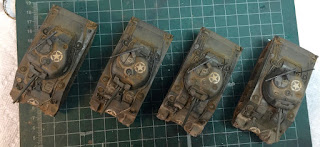This morning I decided to experiment with some brick painting techniques. Since I did not have bricks, I had to first create a quick brick wall segment to work on. I suspect that lots of folks have problems building terrain out of foam board, so what follows is a quick tutorial on creating the little wall segment I made above. I did this quick and dirty, with little attention to detail. If you want a better result, definitely spend more time carefully sculpting the bricks. For me though, this was just enough to let me experiment with powders.
There are two ways I know of getting the effect of mortar on bricks. The first is using enamels. I am partial to that method already, because cleanup and blending is quite easy using thinner. I already use enamels on most of my models, so it is not much of a step to use them on buildings.
The second approach is to use pigments to simulate mortar. This has the advantage that the grainy texture of the pigments add a lot to the realism. The down side is that pigments are very messy and do not wear well for gaming miniatures. Irrespective of this fact, I think I prefer the pigment method. There is a nice tactile quality to the process, and the results are nearly instantaneous. The above wall segment took about an hour in total. The next step would have been to add dirt, streaking effects, and perhaps some mossy areas. Due to purity seal foggy on me, I don't get to experiment further. That wall segment is currently a fuzzy white color. Damn you purity seal! (It bears mentioning again, never, ever, ever, EVER, use lacquer from a spray can. By brush or by airbrush are models protected)
When sculpting with foam board it is necessary to peal off one of the paper sides in order to expose the foam.
To sculpt the bricks I used an exact knife and tooth pick. A press mold is a better way to accomplish this. I normally take an old paint brush and pull out the bristles. The metal tip can then be bent into a nice rectangle shape and used as a mold.
To get a nice smooth finish I put on a little modeling paste. My paste had dried out so it was not ideal. Again, take time doing this.
A quick sanding of the bricks and plasterwork provides a relatively nice surface to paint.
I used three colors of paint for the bricks. The goal was to provide a nice top coat on the plaster. You can see how my sloppy brick work really shows through!
The fun step involves loading up the model with Secret Weapon Miniatures white weathering powder. I haven't had a use for this color before.
After working the powder in with a brush I licked my finger and used it to rub away the powder on the bricks. The weathering powder tastes terrible by the way.












































